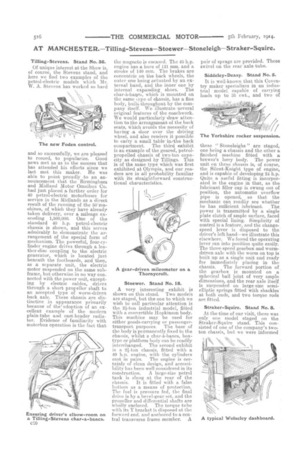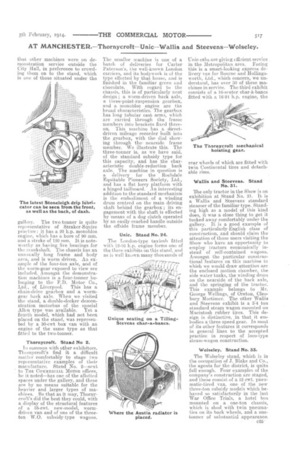THE COMMERCIAL MOTOR-5th February, 194. AT MANCHESTER.—Tilling-Stevens—Stoewer—Stoneleigh — Straker ,- Squire.
Page 16

Page 17

If you've noticed an error in this article please click here to report it so we can fix it.
S i6 Tilling-Stevens. Stand No. G.
Of unique interest at the Show is, of course, the Stevens stand, and here we find two examples of the petrol-electric models which Mr. W. A. Stevens has worked so hard
and so successfully, we are pleased to record, to popularize. Good news met us as to the success that has attended his efforts since we last met this maker. He was able to point proudly to an announeement that the Birmingham and Midland Motor Omnibus Co. had just placed a further order for 40 petrol-electric motorbuses for service in the Midlands as a direct result of the running of the 50'machines, of which they have already= taken delivery, over a mileage exceeding 1,500,000. One of the standard 40 h.p. petrol-electric chassis is shown, and this serves admirably to demonstrate the arrangement of the special form of mechanism. The powerful, four-cylinder engine drives through a leather-disc coupling to the electric generator, which is located just beneath the footboards, and 'then, as a separate unit, the electric motor suspended an the same subframe, but otherwise in no way Connected with the power unit, excepting by electric cables, drives through a short propeller shaft to an accepted type of worm-driven back axle. These chassis are distinctive in appearance primarily because of the adoption of an excellent example of the modern plain-tube and cast-header radiator. Evidence of familiarity with motorbus operation is the fact that.
the magneto is encased. The 40 h.p. engine has a bore of 121 mm. and a stroke of 140 mm. The brakes are concentric on the back wheels, the outer one being actuated by an external band, and the inner one by internal expanding shoes. The char-k-banea, which is mounted on the same uype of chassis, has a fine body, built throughout by the company itself. We illustrate several original features of the coachwork. We would particularly draw attention to the. arrangement of the back seats, which avoids the necessity of having • ,a door over the driving wheel. and also renders it possible to cany a small table'in.othe back compartment. The third exhibit is an example of the geared, petrolpropelled chassis of two-ton capacity as designed by Tillings. This is of the same type which was first exhibited at Olympia, and our readm's are in all probability familiar with its straightforward constructional characteristics.
Stoewer. Stand No. 18.
A very interesting exhibit is shown on this stand. Two models are staged, but the one to which we wish to call particular attention is tho 2i-ton industrial model, fitted with a convertible Hopkinson body. This machine may be used for either goods-carrying or passengertransport purposes. The base of the body is permanently fixed to the chassis, whilst a char-h-bancs, boxtype or platform body can be readily interchanged. The second exhibit is a 2i-ton chassis, fitted with a 40 h.p. engine, with the cylinders cast in pairs. The engine is certainly of clean design, and accessibility has been well considered in its
construction. A large-size petrol tank is slung at the rear of the
chassis. It is fitted with a false bottom as a means of protection. The fuel is pressure fed, the final drive is by a bevel-gear set, and the propeller and differential shafts are wholly enclosed. The torque tube with its Y bracket is disposed at the forward end., and anchored to a central transverse frame member. A
pair of sprags are provided. These swivel on the rear axle tube.
Siddeley-Deasy. Stand No. 5.
It is well-known that this Coventry maker specializes in an industrial model. capable of carrying loads up to 35 cwt., and two of these " Stoneleighs " are staged, one being a chassis and the other a finished machine fitted with a brewer's lorry body. The power unit on these chassis is, of course, the Silent-Knight type of engine, and is capable of developing 24 h.p. Quite a useful fitting is incorporated in the engine in that, as the lubricant filler cap is swung out of position, the automatic overflow pipe is opened, so that the mechanic can readily see whether he has sufficient lubricant. The. power is transmitted by a single plate clutch of ample surface, faced with special lining. Simplicity of control is a feature, and the change-, speed lever is disposed to the driver's left hand—we illustrate this elsewhere. We found the operating lever ran into position quite easily. The three-speed gearbox and wormdriven axle with the worm on top is built up as a single unit and ready for immediately placing in the
chassis. The forward portion of, the gearbox is mounted on a spherical ball joint of very ample dimensions, and the rear axle itself is suspended on large-size semielliptic springs fitted with shackles at both ends, and two torque rods are fitted.
Straker-Squire. Stand No. 8. •
At the time of our visit, there was. only one model staged on the Straker-Squire stand. This conI sisted of one of the company's two-. ton chassis, but we were informed that other machines were on demonstration service outside the City Hall, in preference to crowding them on to the stand, which is one of those situated under the
gallery. The two-tonner is quite representative of Straker-Squire practice : it has a 20 h.p. monohloo engine, which has a bore of 90 mm. and a stroke of 120 mm. It is noteworthy as having five bearings for the crankshaft. The chassis has an unusually long fram.e and body area, and is worm driven. An example of the four-ton axle, and of the worm-gear exposed to view are included. Amongst the demonstration maclinca is a four-tonner belonging to the F. D. Motor Co., Ltd., of Liverpool. This has a chain-drive gearbox and a wormgear back aide. When we visited the stand, a double-decker demonstration motorbus of the special Allen type was available-. Yet a fourth model, which had not been planed on the stand, was represented by a 30-cwt box van with an engine of the same type as that fitted to the two-tanner.
Thornycroft. Stand No 2.
In common with other exhibitors, Thornyeroft's find it a difficult matter comfortably to stage two representative examples of their manufacture. Stand No. 2—next to THE COMMERCIAL MoToa offices, be it noted—has one of the allotted spaces under the gallery, and these are by no means suitable for the heavier and larger types of machines. Be that as it may, Thornycroft's did the best they could, with a display of the structural features of a 35-ewt. new-model, wormdriven van and of one of the threeton W.O. subsidy-type wagons.
The smallec machine is one of a batch of deliveries for Carter Paterson's, the well-known Londou carriers, and its bodywork is of the type effected by that house, and is finished in the familiar green And chocolate. With regard to the chassis, this is of particularly neat design ; a worm-driven back axle, a three-point-suspension gearbox, and a nionobloc engine are the broad characteristics. The gearbox has long tubular cast arms, which are carried through the frame members into brackets fixed thereon. This machine has a directdriven mileage recorder built into the gearbox, with the dial, showing through tho, nearside frame member. We illustrate this. The three-tonner is, as we have said, of the standard subsidy type for this capacity, and has the characteristic double-reduction back axle. The machine in question is a delivery for the Rochdale Equitable Pioneers Society, Ltd., and has a flat lorry platform with a hinged tailboard. An interesting addition to the standard mechanism is the embodiment of a winding drum centred on the main driving shaft behind the gearbox ; its engagement with the shaft is effected by means of a dog clutch operated by an easily-reached handle outside the offside frame member.
Unic. Stand No. 24.
The London-type taxicab fitted with 12-10 h.p. engine forms one of the three exhibits on this stand, and as is well known many thousands of
Unie cabs are giving efficient service . in the Metropolitan area. Facing this is a smart-looking express delivery van for Bourne and Hollingsworth, Ltd., which concern, we understand, has over 30 of these machines in service. The third exhibit consists of a 16-seater char-a-basics fitted with a 16-24 h.p. engine, the rear wheels of which are fitted with twin Continental tires and detachable rims.
Wallis and Steevens. Stand No. 31.
The only tractor in the Show is On exhibition at Stand No. 31. It is a Wallis and Steevens standard steamer of the familiar type. Standing high as a model of this kind does, it was a close thing to get it tucked away comfortably under the gallery. It is a good example of this particularly-English class of construction, and should claim the attention of those users visiting the Show who have an opportunity to employ tractors economically instead of self-contained wagons. Amongst the particular constructional features on this machine to which we would draw attention arc the enclosed motion chamber, the side water tanks, the winding drum on the nearside of the back axle, and the springing of the tractor. This example belongs to Ur. George Wellings, •of Oreton, Cleobury Mortimer. The other Wallis and Steevens exhibit is a 3-4 ton standard steam wagon mounted on Macintosh rubber tires. This design is distinctive, in that it embodies a three-speed gear. In most of its other features it corresponds in general lines to the accepted practice in respect of loco-type steam-wagon construction.
Wolseley. Stand No. 55.
The Wolseley stand, which is in the occupation of J. Blake and Co., the agents for the district, is quite _full enough. Four examples of the company's construction are staged, and these consist of a 12 cwt. pneumatic-tired van, -one of the new three-ton subsidy models which behaved so satisfactorily in the last War Office Trials, a hotel bus mounted on a one-ton chassis, which is shod with twin pneumatics on its back wheels, and a onetonner of substantial appearance. 0-25'


































